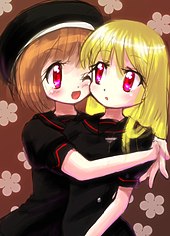
Yuri (Japanese: 百合, lit. "lily"), also known by the wasei-eigo construction girls' love (ガールズラブ, gāruzu rabu), is a genre of Japanese media focusing on intimate relationships between female characters. While lesbian relationships are a commonly associated theme, the genre is also inclusive of works depicting emotional and spiritual relationships between women that are not necessarily romantic or sexual in nature. Yuri is most commonly associated with anime and manga, though the term has also been used to describe video games, light novels, and literature.
Themes associated with yuri originate from Japanese lesbian fiction of the early twentieth century, notably the writings of Nobuko Yoshiya and literature in the Class S genre. Manga depicting female homoeroticism began to appear in the 1970s in the works of artists associated with the Year 24 Group, notably Ryoko Yamagishi and Riyoko Ikeda. The genre gained wider popularity beginning in the 1990s; the founding of Yuri Shimai in 2003 as the first manga magazine devoted exclusively to yuri, followed by its successor Comic Yuri Hime in 2005, led to the establishment of yuri as a discrete publishing genre and the creation of a yuri fan culture.
As a genre, yuri does not inherently target a single gender demographic, unlike its male homoerotic counterparts boys' love (BL, marketed towards a female audience) and gay manga (marketed towards a gay male audience). Although yuri originated as a genre targeted towards a female audience, yuri works have been produced that target a male audience, as in manga from Comic Yuri Hime's male-targeted sister magazine Comic Yuri Hime S.